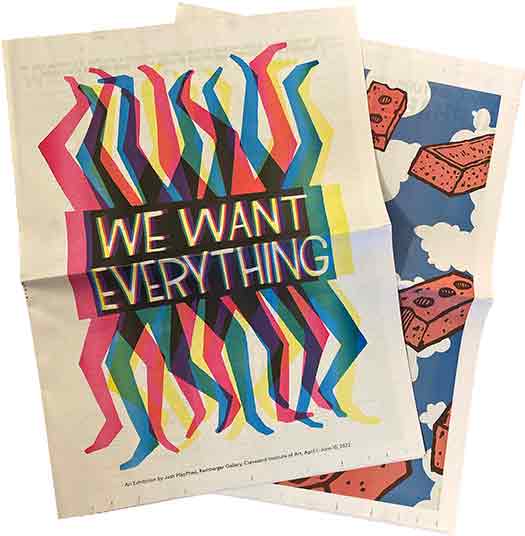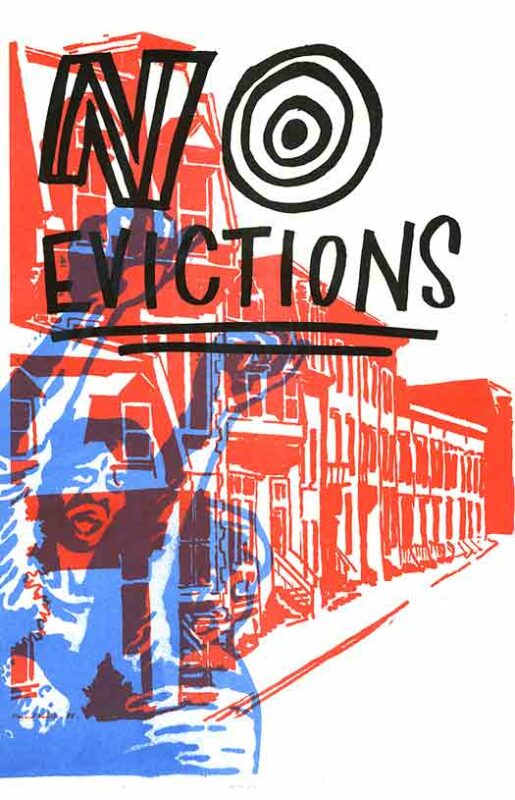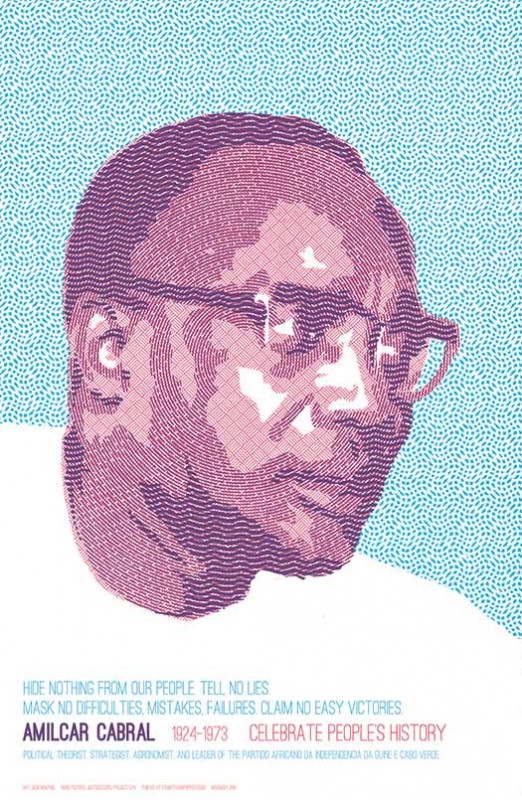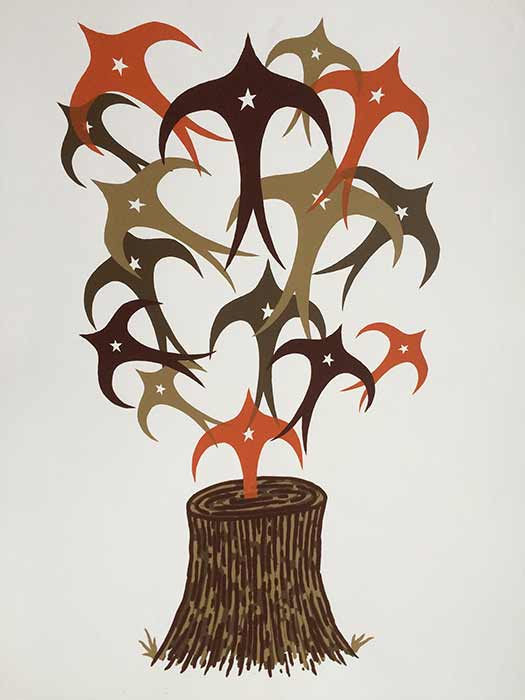Liam O’Donoghue an article online that continues the discussion/critique of Shepard Fairey thats been ongoing online over the past 6-9 months. He’s posted his piece “Shepard Fairey’s Image Problem” on multiple Indymedias (here’s the link to the story on NYC Indymedia.) and I’m going to paste the whole thing below:
As if Wal-Mart didn’t have enough controversies to deal with, imagine the consternation in the PR war room when news hit that the retail giant was selling t-shirts bearing a Nazi SS skull. As the story unraveled, it turned out that Wal-Mart’s designer had ripped off the image from pop art superstar Shepard Fairey, whose reference for the Gestapo logo was 1960’s “biker culture.” Oops.
Using the international notoriety of his global “Andre the Giant has a posse” street art campaign as a platform, Shepard Fairey has leveraged his prolific output and iconic, anti-authoritarian style into a mini-empire. Through his ObeyGiant company (Motto: Manufacturing Quality Dissent Since 1989), he churns out screen-printed posters, clothing, and limited-run merchandise including skateboards and laser-engraved watches. His other design company, Studio Number One, specializes in branding, promotional campaigns and “identity systems” for corporate clients including Mountain Dew, Virgin, and Honda. He is also founder and creative director of Subliminal Projects art studio in Los Angeles and uber-hip Swindle magazine. His audience and the value of his work has surged in recent months on the popularity of his now-ubiquitous Obama posters.
Although Fairey “didn’t get bent out of shape” about Wal-Mart ripping him off, he originally launched his ObeyGiant clothing line because he saw that the Urban Outfitters chain was selling “bootlegged” shirts with his Giant logo. “To see it in there, just ripped off, knowing that somebody just made a bunch of money selling the t-shirts to Urban Outfitters, and here I am, just barely being able to pay my rent was definitely upsetting to me,” Fairey told me during an interview for Mother Jones. “The reason I get pissed off about stuff like that is because I didn’t build up the resonance for that image just to hand it off to someone to exploit.”
This irony is not lost on Lincoln Cushing, an art historian and author who recently brokered a royalty agreement between Fairey and the estate of deceased Cuban artist Rene Mederos over a design of Che Guevara and Camilo Cienfuegos that Fairey essentially swiped and slapped his “Obey” logo onto. When confronted, Fairey was quick to cut a check to Mederos’s family, but Cushing described the Mederos episode as a common dynamic. “Many U.S. artists don’t seem to treat the intellectual property rights of third world artists the same as fellow U.S. artists,” Cushing said, and added that artists aren’t the only ones willing to steal from those still isolated from the U.S. economy. “For many years the web-based sales catalog of Barnes and Noble marketed over 30 unauthorized digitally-reproduced ‘Cuban posters.’ I contacted them many times about dealing with this properly, and they never responded.”
Cushing has since posted a list of ”Best Practices” for recycling art on his Web site, offering suggestions such as “admit that you are using preexisting art” and “ask for permission.” However, prior to the Mederos episode, Cushing had already begun working informally with a group of political artists and art historians including Favianna Rodriguez, Josh MacPhee, and Mark Vallen to catalogue Shepard Fairey’s many appropriations with hopes of bringing attention to the artists and social movements from which they originated and advancing the dialogue around the ethics of art appropriation.
Although Fairey has lifted designs from sources ranging from 19th century Austrian artist Koloman Moser to fellow “streetwear” designer Erik Brunetti (creator of the influential Fuct brand), his most common (and usually uncredited) “references” are taken from 20th century radical popular movements and communist governments, including: the Industrial Workers of the World, the Puerto Rican Young Lords, the Black Panthers, various “third world” solidarity movements, and, of course, the former Soviet Union, China and Cuba.
Far from denouncing all forms of art “sampling,” Josh MacPhee and Favianna Rodriguez have just published “Reproduce and Revolt,” a compilation of more than 600 copyright-free images from artists around the world. They hope the book will facilitate networking among artist activists and provide an inspiring cache of graphics for social justice groups. According to Rodriguez, “We want to build a support network, but also talk about accountability, because a lot of young artists want to be successful like Shepard, but they don’t realize he’s disconnecting images of important struggles from their roots.”
Through the Justseeds artist cooperative, MacPhee has also been “waging a war” against cultural amnesia since 1998 with an ongoing “Celebrate People’s History” poster series, which he often uses in classroom presentations. “The People’s History posters are not about taking graphics from history, but producing new graphics about that history, and encouraging people to learn, to pique their interest,” said MacPhee, who recently posted a long analysis related to the Fairey controversy on his blog. “In some ways, Shepard’s project is the complete inverse of that. His is about stripping the historical context from actual graphics and using them to make money because they imply some sense of authenticity.”
Straddling the corporate world and the streets (which Fairey is still known to “bomb” with wheat-pasted posters occasionally), Fairey’s reputation is an incendiary topic in the blogosphere, with his fans and detractors in dispute over the legitimacy and implications of his work. Fairey, himself, makes no apologies. He said, “Knowing that I have an audience that’s younger, a lot of the stuff that I do is designed to try to circulate things that I think are awesome back into a new crowd. My desire to learn about Che Guevara was due to the massive perpetuation of the image.”
Realist painter and art activist Mark Vallen, whose “Obey Plagiarist” article provides a deep examination of Fairey’s specific “appropriations” doesn’t buy Shepard’s spiel. He said, “There is no more chance of learning about revolutionary art and politics through Fairey’s self-promotional posters than there is in understanding Beethoven’s music from hearing it used in advertising jingles.”
According to the Web site of Fairey’s Studio Number One company, “Our clients turn to us knowing that we possess the expertise to tap into the counterculture seamlessly.” Due to his undeniable knack for capturing the attention of the ever-fickle youth market, it’s no surprise that the recent flurry of attention regarding his plagiarism has not put a dent in Fairey’s burgeoning marketing and commercial design career. Fairey will undoubtedly continue to speak alongside creatives and “futurists” from Sony and Starbucks at conferences held by the likes of PSFK Consultancy & Trend Research Services, as he recently did in Los Angeles.
Regardless of originality or aesthetic preferences, it’s Fairey’s corporate relationships and business model that trigger the most resentment from some of his critics. “The people who pay Fairey are the corporate elite that have oppressed the very people he’s stolen from,” Rodriguez said.
“What is important to me is how Fairey exemplifies in many ways the operational model of capitalism,” MacPhee added. “He extracts resources largely from political struggles of Third World and working class people, and then simultaneously sells a slightly processed version of the resources to both wealthy elites in the North, but also cheaper mass-commodity versions to the very same people he is stealing from!”
Related Links:
The research that preceded this article was conducted for an interview I did with Shepard Fairey for Mother Jones magazine (March/April 2008. Here is a link to that interview:
http://www.motherjones.com/interview/2008/03/interview-shepard-fairey.html
Lincoln Cushing’s response to this interview was published in the following issue of Mother Jones (May/June 2008)
http://www.motherjones.com/letters/2008/05/backtalk.html
Journalist Aura Bogodo disputed Fairey’s version of a conversation between them that was mentioned in the Mother Jones interview. Here is a link to her powerful response:
http://tothecurb.wordpress.com/2008/05/29/i-have-a-name-an-open-letter-to-shepard-fairey/








Just so you know, Shepard Fairey’s idea of ‘reference’ is downright theft. He has played ignorant for years. If you or I were to do the same thing people would lash out at us. For some reason he has built a career off of stealing images from other artists.
Shepard Fairey is a copyright violator. Anyone who can do a Google search of his name knows that. So why on earth did Barack Obama, the so called Champion of art and culture, hand pick Shepard as his official campaign artist? I know Obama has said some great things about funding art education and art programs. But at what cost? Actions speak louder that words and it seems Obama does not care about our rights as artists. As an artist I won’t vote my rights as an artist away by voting for Obama. For the first time in my life I will be voting for a Republican. Obama crossed a line and he threatens working artists!
Again, this story is nothing compared to a story about Obama that should be exposed. They attacked Joe the Plumber, but the media and the McCain campaign has not attacked Shepard the Artist. Shepard Fairey is the artist behind the HOPE poster of Obama. Obama has openly praised him and has openly supported his illegal activity on the streets. So why did Obama refuse funds from Rezko, but accepts over $400,000 from another criminal who takes part in crimes and damage to property that cost tax payers billions per year? Visit the link below. It is all there. Obama is NOT the Champion of Art and Culture. If he was he would not openly support an artist who does not acknowledge international copyright law. How can someone under Obama’s paw laugh about being arrested a dozen times for property damage and the media not take notice?
http://www.lgwilliams.com/obama/obama_poster_challenge2.html
Shepard Fairey is the biggest copyright infringer working today. People need to learn more about copyright laws and what exactly Shepard Fairey has done. He is not a friend to the arts! People should ask why Obama walked hand in hand with a copyright infringer when he is supposed to be this big supporter of artists and their work. Look up what Mark Vallen and Brian Sherwin have said about Fairey. There is more truth on those two blogs than you will see anywhere else. True street art does not involve huge price tags and if Fairey is not going to respect copyrights he should not throw a hissy fit when someone exploits his art like he just did with a comment on his site about Ebay sellers.
Actually Shepard Fairey is a Capitalist opportunist catering to elitists. Big money from the investments of a publisher and PR team have fostered media attention for his art. Hell, they now credit him as being the first artist to make street art and counter culture art mainstream. All I can say to that is SAMO.
All you sour pusses need to lighten up and get outside for some fresh air. You people make me sick.
Credit in life goes to the ones in the arena, not the audience.
Might wanna think about that.
NO DISSENT OR TRANSGRESSION IN FAIREYS ART.WONDER IF HE UNDERSTANDS THE LARGER POLITICAL AGENDA HE HAS SOLD OUT TO. THE OBAMA FIGURE IS THE EPITOME OF A CULT OF PERSONALITY BEING MARKETED TO THE PEOPLES OF THE U.S… I DID NOT AND WILL NOT BELIEVE THE HYPE. ASSOCIATING HIMSELF WITH AMERICAN POLITIC AND PUMPING OUT MORE AMERICAN CRAP, HAS MADE HIM THE
ULTIMATE SELL OUT OF THE STREET ART GENERATION.IN MY OPINION FAIREY WAS NEVER A GRAFF ARTIST. AN ARTIST, YES. BUT NOT A GRAFF ARTIST. SIMPLY A CAPITALIST ARTIST. NO DEVIATION IN THIS REALM THESE DAYS. EVEN BANKSY ASSOCIATES WITH THIS WICKEDNESS. THE REAL CRIME HE IS COMMITTING IS AIDING IN LEADING THE YOUTH OF AMERICA DOWN A BLIND ALLEY. MORE INK, MORE PAPER, MORE CHEMICALS AND SHIT FROM CHINA(INCLUDING HIS CLOTHING LINE) SO AMERICANS CAN PUT THE IMAGE OF THIS BARACK DEVIL ON THE BUMPERS OF CARS WE ARE DRIVING STRAIGHT TO HELL.HAD TO VENT. ART IN AMERICA HAPPENED ALREADY.80’S,90’S GRAFF . LET FAIREY, BANKSY, DAMIEN HIRST, ALL THESE SELL OUTS KNOW, THEY AIN’T SAYING NOTHING.THEY ARE JUST AS GANGSTER AS THE BANKERS AND COPS THEY ARE SUPPOSEDLY RESPONDING TO.NOTE TO SELF, DON’T BE SURPRISED WHEN THE PEOPLES LIBERATION ARMY ARRIVE ON OUR SHORES WITH OBEY FATIGUES ON. FOR REAL .
This article sums up Fairey real well,
http://www.myartspace.com/blog/2009/01/shepard-fairey-obey-copyright.html
interesting enough, super touch has posted a response to all this obey plagarism:
http://www.supertouchart.com/2009/02/02/editorial-the-medium-is-the-message-shepard-fairey-and-the-art-of-appropriation/
Shepard Fairey should be called out on stealing from minority artists and for twisting the message of other artists. I read articles that open my eyes to how horrible he is as a man. He does not allow artist to comment visually on his art but takes, takes, takes all he can from minority artists and photographers. If he thinks that fair use is creative freedom he should accept that artists will comment on his work visually and profit from it just as he does. NPR did not ask him about any of his contradictions and ICA did not either. He is a hypocrite and steals culture for his own profit and messages. He is a rightest selling a leftist message for his own fame and fortune. Support the ASL group in exposing this fraud. Please read and see what he does from the words of this man who has been critical of this artist,
http://www.myartspace.com/blog/2009/02/shepard-fairey-sues-associated-press.html
The Phantom Street Artist has said
People will speak of a Future Day and Time when a coined term will come from the voice of the streets. The term will be a definative colloquial called Fairey Use TM to mean when an artist out of disrespect betrays important historical and revolutionary cultures, languages and authors to advance his own selfish interest in greed and mammon. This is called Fairey Use TM when an artist steals from cultural references and fails to give proper credit then hides under interpretative legal defense.
In a sentence:
Mommy is that artist pulling a Fairey Use?
Phantom Omnicient Says…
What you Buy will one day Buy you..
What you OWN will one day OWN you.
What you SELL will one day SELL you
Marty Think’s statement comes from the voice of a typical sell out public relations officer whose has been retained to handle only the marketing and publicity of the filthy rich. He states that he is ill from the criticism of his public relations client. What this publicist is really saying is that…
“All you sour pusses need to lighten up and get outside for some fresh air. You people make me sick my clients makes a living from dis-crediting historical archives and cultures and that is ok as long as I am paid.
Credit in life goes to the one in the arena as long as you retain my public relations services for a substantial large fee.
I will stand behind and market any message no matter how plastic or empty. You are not the audience and will never be the audience of mass media. Your voice will never be heard in the arena as media is the playground of the wealthy rich and elite. You might wanna think about that, now where is my shoe.”
From the desk of Make me feel good publicity…
disOBEYDUHFAIREY
OBEY’$ Shepard Fairey presents himself to the Media and Culture as a progressive political underground figure of great social conscience associated with Ultra-Cool Rock Star Hipsters like Zack De La Rocha and Henry Rollins.
In reality he is meticulously shaped by the marketing of Corporate Publicist; look carefully you will see that Fairey’s work is the action of a Post Colonialist right-winger whose interest only exploits and ransacks important leftist historical motifs and revolutionary imagery with an tactile agenda so that the RIP-OFF artist can laugh all the way to the bank.
Now his Public relation officers have released that he stands for the Artist everywhere in citing Fair Use but in reality he is suing the AP only to protect His ASS-ets , his name in the media and other potential lawsuits.
These are a few of my favorite things..
When the dog lies…
hmm. informative ))
Yes intellectual property rights need to be protected more strenuously. It’s an exchange thing, people who contribute things of value to our society should receive good exchange in return and theft of their work prevents this.